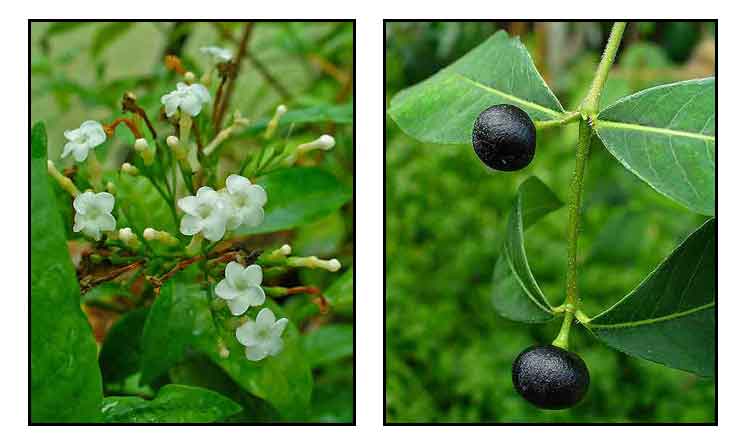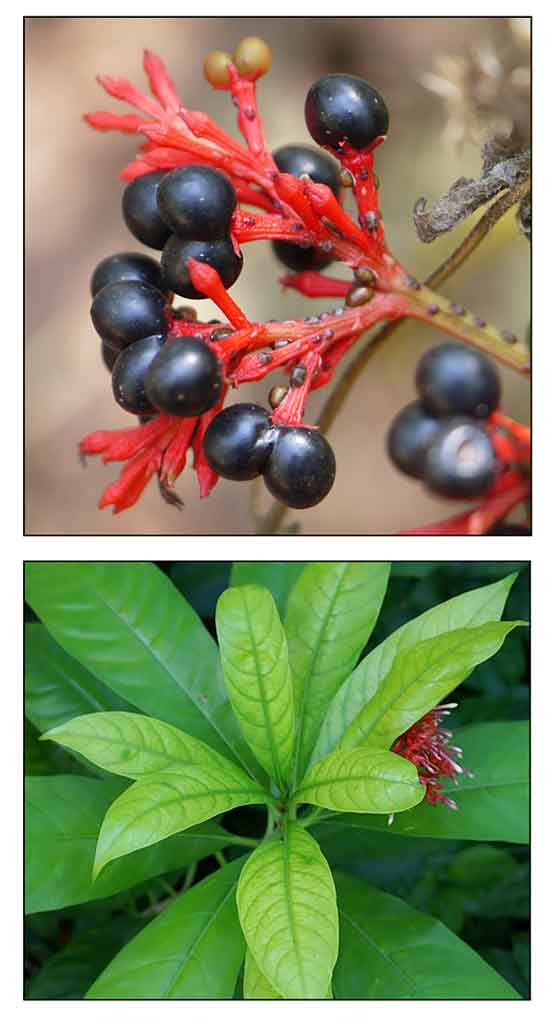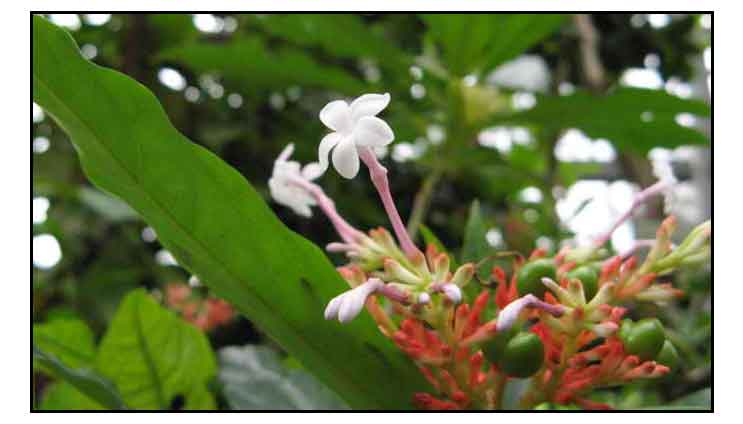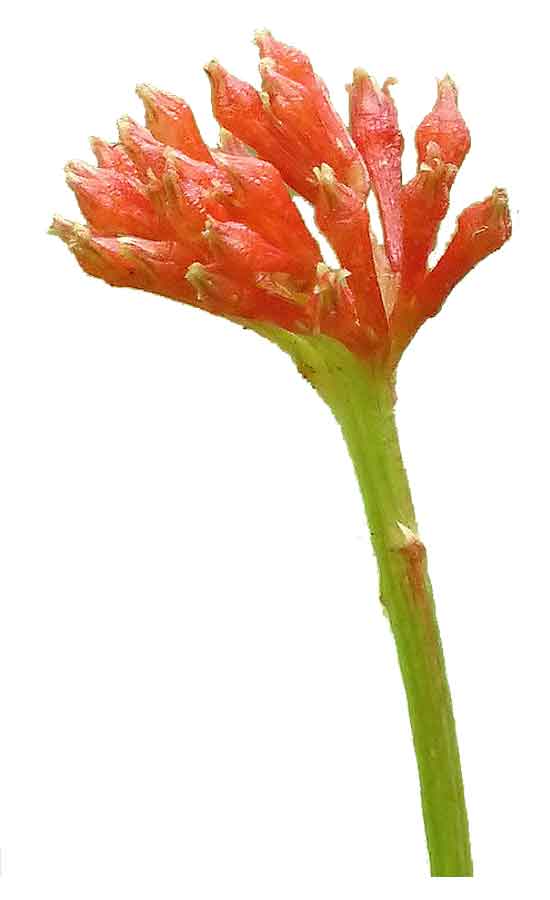 Gen info Gen info
- Rauvolfia (or, Rauwolifa) is a genus of evergreen trees and shrubs, commonly known as devil peppers, in the family Apocynaceae.
- Etymology: The genus name Rauwolfia honors Leonhard Rauwolf, a 16th-German physician. Specific epithet serpentina refers to the plants long, tapering snake-like roots.
-
There are more than 100 species in the Rauwolfia genus.
- Rauwolfia has been mentioned in an old Hindu manuscript (1000 BC) as well as works of Charaka (2nd century AD) under the Sanskrit name Sarpagamdha. (26)
- It has been used in a long list of unrelated diseases viz., corneal opacity, poisonous snake bites, diarrhea, dysentery, cholera, uterine contraction, insomnia and insanity. In Patna and Bhagalpur in Bihar it was sold as 'Pagla-ka-dawa' (insanity herb). (26)
- Of the 139 odd species of Rauwolfia, eight grow in India. The species exhibit considerable difference in quality and content of therapeutic alkaloids; among them, the most useful is R. serpentina.
- R. serpentina has been use in India's folk medicine for centuries. It was brought to notice in Western medicine in a milestone paper in 1949 by Indian physician Rustom Jal Vakil as an antihypertensive. By 1949, more than 90% of Indian physicians were using Rauwolfia in the treatment of hypertension. It fell out of popularity when adverse effects, including depression and cancer, became associated with it. (13)
Botany
• Serpentina i is a small evergreen erect shrub with whorled branches and milky sap. Leaves are opposite, entire, oblong-elliptic, up to 30 centimeters long. Flowers are white, clustered in axillary cymes, with slender corolla tube and 5 spreading lobes. Fruit is a small drupe, shiny, black or purple.
• Shrubs to 1 m tall, erect, glabrous. Stems usually unbranched, slender, straw colored. Leaves grouped near stem apex, in whorls of 3-5; petiole 1-1.5 cm; leaf blade narrowly elliptic or obovate, membranous, 7-17 X 2-9 cm, base cuneate, apex acuminate or rarely obtuse; lateral veins 7-15 pairs. Cymes congested; peduncle 5-13 cm, red or reddish. Pedicel and calyx red or reddish. Corolla white, tube cylindric, 1-1.8 cm, inflated at middle and pilose inside distal half; lobes obliquely suborbicular, 1.5-3.5 mm. Stamens inserted at middle of corolla tube. Ovaries connate in basal half. Drupes ellipsoid, ca. 8 mm, connate for half their length. (Flora of China)
Distribution
- Introduced to the Philippines.
- Native to Andaman Is., Assam, Bangladesh, Cambodia, China South-Central, East Himalaya, India, Jawa, Laccadive Is., Laos, Lesser Sunda Is., Malaya, Myanmar, Nepal, Sri Lanka, Thailand, Vietnam.
(12)
- An endangered species due to overexploitation and extraction of roots.
- Considered critically endangered species by the IUCN.
 Constituents Constituents
- Yields bioactive constituents: yohimbine, reserpine, ajmaline, deserpidine, rescinnamine, serpentinine.
- Roots have yielded two alkaloids (1% of the dried root),
a lot of resin and starch.
- Study yielded phytosterols, oleic acid, and unsaturated alcohols, and five alkaloids classified in two groups: three in the ajmaline group, white crystalline, weak bases, ajmaline, ajmaliine, and ajmalicine; and two in the serpentine group, yellow crystalline stronger bases, serpentine and serpentinine.
- The principal active constituent is the alkaloid reserpine.
- Rauwolfia yields alcohols, sugars and glycosides, fatty acids, flavonoids, phytosterols, oleoresins, steroids, tannins and alkaloids. The most important of the alkaloids are indole alkaloids, more than 50 of which have been isolated in the plant. (13)
-
All parts of the plant, including stems and leaves, contain indole alkaloids. Identified indole alkaloids include ajmalidine, ajmaline, ajmalinine, ajmalicine, aricine, canescine, coryanthine, deserpidine, isoajmaline, isoserine, isoserpiline, lankanescine, neoajmaline, papaverine, raubasine, raucaffricine, rauhimbine, rauwolfinine, recanescine, rescinnamine, reserpiline, reserpine, reserpinine, sarpagine, serpentine, serpentinine, thebaine, yohimbine, and yohimbinine. (Panwar GS, Guru SK. Alkaloid profiling and estimation of reserpine in Rauwolfia serpentina plant by TLC, HP-TLC and HPLC. Asian J Plant Sci. 2011;10(8):393–400) (Woodson RE, Youngken HW, Schlittler E, Schneider JE. Rauwolfia: Botany, Pharmacognosy, Chemistry and Pharmacology. Boston, MA: Little, Brown and Company; 1957. pp. 32–33) (13)
- Methanolic root extract yielded alkaloids, carbohydrates, flavonoids, glycosides, cardiac glycosides, phlobatannins, resins, saponins, steroids, tannins, and triterpenoids, while quantitatively the extract was rich in total phenols. (see study below) (15)
Properties
- Bitter, cool.
- Considered hypotensive, neuroleptic, sympatholytic.
- Febrifuge, antitussive, diuretic.
- In Siddha medicine, considered antihypertensive, styptic, nervine-tonic and abortifacient.
- Studies have suggested hypotensive, hypolipidemic, antibacterial, corrosion inhibitory, aldose reductase inhibitory, antiatherogenic, antifungal, mosquito larvicidal, hepatoprotective, renoprotective, neuroprotective properties.
Parts used
Roots.
 Uses Uses
Edibility
- Root bark used to develop bitterness to prepare Ranu dabai, which is utilize in the preparation of the beverage jhara as a source of starter culture. Terai of West Bengal use the root bark used to develop the bitter taste in rice beer. (25)
Folkloric
- No reported folkloric medicinal use in the Philippines.
- A medicinal plant of antiquity. Used for millenia inn India. Used to counter the effects of poisoned arrow. Ghandi reported used it as a tranquilizer.
- Used as febrifuge, as stimulant to uterine contractions, for insomnia and insanity.
- Used for high blood pressure.
- For millenia, used as antidote to stings and bites of insects and poisonous reptiles.
- Used in Ayurveda, Unani and folk medicine systems for reducing blood pressure, for its CNS depressant effect, and as hypnotic.
 - Ingredient to an Ayurvedic herbal mixture once used in the treatment of schizophrenia. - Ingredient to an Ayurvedic herbal mixture once used in the treatment of schizophrenia.
- In India, referred to as the "insanity herb," used to treat mental disorders, i.e., anxiety, paranoia, nervousness.
- In Siddha medicine, root power given with equal amounts of Triphala powder twice daily is used for hypertension and associated headache and giddiness. Root powder given for amenorrhea, oligomenorrhea and dysmenorrhea-like abnormalities. For snake bites and scorpion bites, root powder mixed with Piper cubeba and salt applied externally to the bite as well as taken internally. For hysteria in women and epilepsy, root powder is mixed with equal amounts of powder of Nardostachys jatamanji.
- In Bangladesh, root decoction used for treatment of headaches. Also used for treatment of AIDS and splenic diseases. Fresh leaf juice applied to prevent eye inflammation. Fresh root juice or dried root powder soaked in water used orally for asthma or respiratory problems. Root juice mixed with leaf juice of A. paniculata and Nyctanthes arbortristis used for treatment of scabies. Root paste used for treatment of itches, boils, and eczema.
(25)
- In Bangladesh, root and leaf paste, made into pills and sundried, used to treat malarial fever. Mixture of root paste and black pepper used for malaria. Mixture of leaf juice with Andrographis paniculata and Azadirachta indica with honey used for treatment of malaria. (25)
Others
- Wood: Used for woodcarving and lathe work.
- Ethnoveterinary: In Madhya Pradesh, India, used by tribal livestock owners to treat loose motion with 60-70% efficacy: A mixture of 20-30 gm of roots with 50-60 gm sugar for 2-3 days. In Central Nepal, 10 gm or more of root paste for fever, menstrual disorders, until recovery (25)
Studies
• Pharmacologic Activities: Studies on the root have shown: (1) Action on the vasomotor center, with generalized vasodilation and lowering of blood pressure. (2) Depressant action on the nervous system (3) Sedative action on the gastric mucosa (4) Stimulation of the bronchial musculature.
• Hypotensive: Study showed R. serpentina proved capable of lowering both systolic and diastolic blood pressure. (3)
• Mechanisms of Hypotensive Action of Reserpine: Studies on the alkaloid reports: (1) the marked hypotensive effect was in part due to depression of CNS mechanisms. It was less marked in decerebrate animals. (2) Effect was, in part, a result of a direct inhibitory effect on the musculature of the blood vessels. (3) There was a fall i cardiac output of the isolated heart. (4) Subsequent studies have suggested the effect mediated solely via central nervous mechanisms. (4)
• Strictosidine Synthase: STR1 from R. serpentina is of primary importance for the biosynthetic pathway of the indole alkaloid ajmaline. STR1 catalyzes a Pictet-Spengler-type reaction and represents a novel six-bladed ß-propeller fold in plant proteins. Mutagenesis experiments demonstrate the essential role of Glu-309 in catalysis. (5)
• Psychoactive: Considered a theoretical psychoactive due to the yohimbane-type alkaloids (corynanthine, isorauhimbine, and yohimbine.
• Side Effects / Depression: Crude and purified derivatives are considered free of serious toxic reactions. Mild side effects are frequent, consisting of nasal stuffiness, fatigue, weight gain, decreased initiative, drowsiness, nightmares, and diarrhea. Symptoms can be relieved by reducing the dosage without sacrificing its hypotensive effect. In large doses, depression occurs with significant frequency. (6)
• Hypolipidemic: Study showed root powder of R. serpentina has hypotriglyceridemic and hypocholesterolemic effects with no detectable side effects on liver and cardiac functions. (7)
• Serpasil / Cardiovascular and Respiratory Effects: Serpasil, a crystalline alkaloid obtained from Rauwolfia serpentina, produced a gradual persistent blood pressure and respiratory depression when administered intravenously to barbitalized dogs. No significant blood pressure drop occurred in five unanesthetized dogs with serpasil administration. Serpasil produces a central inhibition of the sympathetic nervous system, possibly through specific hypothalamic depression. (9)
• Antibacterial: Study evaluated the antibacterial effect of RS aqueous and ethanol extracts, with Norfloxacin as control drug. Results showed the ethanol extract exhibited greater antibacterial activity than the aqueous extract against Staphylococcus aureus. (10) Study evaluated the antibacterial effect of four important medicinal plants i.e., Rauvolfia serpentina, Tagetes erecta, Brassica nigra, and Ocimum tenuiflorum. R. serpentina showed excellent antibacterial activity against tested bacterial organisms as compared to Norfloxacin, and greater activity than other plant leaves extract. (20)
• Corrosion Inhibition: Study evaluated an alkaloid extract of R. serpentina as corrosion inhibitor for mild steel in 1 M HCl and H2SO4. Results showed inhibition of corrosion in both acids through absorption process and formation of a protective layer over the mild steel surface. (11)
• Reserpine / Rauwolfia in Hypertension: Reserpine is the most widely studied alkaloid in R. serpentina. It was first isolated and used in 1950. Based on literature review, Rauwolfia appears to be a safe and effective treatment for hypertension. Alseroxylon extract or pure reserpine, an equivalent dose of pure Rauwolfia alkaloids, can also be used for hypertension treatment. Review discusses dosages for Rauwolfia, extracts, root, and tinctures. (see constituents above) (13)
• Rauvolfia serpentina as Inhibitor of Aldose Reductase: In the Himalayan mountain range, extracts of R. serpentina has been known to be effective in alleviating diabetes and its complications. Study sought to prospect for novel plant-derived inhibitors from R. serpentina. Study identified 3 structurally distinct PDMs (plant derived molecules) as best candidates: indobine, indobininer, and 19(S),20(R)-dihydroperaksine-17,21-al. Results report on 2-plant derived indole alkaloids and their 16 structural analogs as potential ARIs. (14)
• Antiatherogenic / Cardioprotective / Hypoglycemic / Roots: Study evaluated the phytochemistry and effect of methanolic root extract of Rauwolfia serpentina on alloxan-induced diabetic mice, The MREt improved the glycemic, antiatherogenic, coronary risk, and cardioprotective indices in alloxan-induced diabetic mice. (15)
• Antimicrobial / Roots: Study investigated the antimicrobial activity of solvents and aqueous extracts of R. serpentina roots against various bacteria and fungi.. The methanol extract showed highest antimicrobial activity against multidrug resistant S. aureus at 100 mg/ml concentration, while S. aureus was the most susceptible bacterium to all extracts. K. pneumonia was resistant against solvent and aqueous extracts. (16)
• Antifungal / Roots: Study evaluated the antifungal activity of aqueous extracts of whole plant, roots, and stems of Rauvolfia serpentina against pathogenic fungi i.e., Alternaria alternata, Aspergillus flavus, and Mucor rouxii.
The aqueous extract of root showed significant higher antifungal activity against Alternaria alternata and Aspergillus flavus than other extracts. (19)
• Mosquito Larvicidal / Aedes aegypti / Fruits: Study evaluated the larvicidal activities of Rauvolfia serpentina fruits against 3rd instar larvae of Aedes aegypti. Highest larvicidal mortality was seen in an ethanol extract at concentration of 200 ppm after 48 hours of treatment. Results suggest potential as indigenous mosquito control agent and alternative to conventional chemical mosquito larvicides. (21)
• Role in Stroke Induced Experimental Dementia: Study evaluated the role of R. serpentina in stroke induced experimental dementia. Global cerebral ischemia induced dementia by occlusion of both common carotid arteries. Administration of RS significantly attenuated induced cerebral alterations and showed neuroprotective effect against oxidative stress, infarct size, and learning and memory impairment. The neuroprotective effect suggests a potential role as prophylactic drug in stroke induced experimental dementia. The effect was attributed to phenolic acid, flavanoids, and tannins. (22)
• Antihypertensive / Antihyperlipidemic: Study evaluated the antihypertensive and antihyperlipidemic therapeutic responses of R. serpentina doses using albino rats. Groups treated with methanolic extract of plant with low dose of 100 mg/kbw (G4) and high dose (200 mg/kbw) daily showed significant (p<0.05) decrease in blood pressure, with significant (p<0.05) effect on serum lipid and protein contents, as well as hepatoprotective and renoprotective potential on tissue sections microscopically studied. (23)
• Effect on Acute Stress/ Antihyperlipidemic: Rauwolfia serpentina has been used for treatment of hypertension and psychotic disorders. Study evaluated the effect of R. serpentina on acute stress and its role in oxidative stress, antioxidant enzyme activities (catalase and SOD), plasma glucose, corticosterone and leptine levels. Results showed it could prevent stress-induced increase in corticosterone, and increase levels of endogenous leptin that attenuates stress-induced activity of HPA axis. (24)
• Herb-Drug Interactions: Potential major interactions with Digoxin (may decrease effect of lanoxin), levodopa (may decrease effect of L-dopa), antipsychotic drugs (increased risk of side effects). Moderate interaction with ephedrine, MAOIs (monoamine oxidase inhibitors), sedative medications, stimulant drugs. antidiabetic drugs, antihypertensive drugs (cause blood pressure to go too low), anticoagulants (increased risk of bleeding or bruising), tricyclic antidepressants (increase risk for side effects). (27)
• Neutralizing Potential against Naja naja Venom / Root: Anti-Snake Venom Serum is the only remedy to treat snake bite victims successfully till date. Study evaluated an aqueous extract of R. serpentina root for antidote properties against Naja naja venom by invitro and invivo methods. In vitro neutralization tests like Acetylcholinesterase, Protease, and ATPase activity of the Naja naja venom were carried and the root extract neutralized all the toxic effects induced by the venom. In vivo assessment of venom lethality (LD50) of Naja naja venom was 0.301 µg. The aqueous root extract effectively neutralized the venom lethality and effective dose (ED50) was 12.88 mg/3LD50 of Nnaja venom. (28)
• Improvement of Glucose Tolerance / Sedating Effect / Root: Oral administration of methanolic root extract (MREt) of Rauwolfia serpentina (10-250 mg/kg) to normoglycemic wister mice showed hypoglycemic activity by reducing mean blood glucose level from 80 to 62 mg/dL after 30 mins while dose of 100-250 mg/kg showed sedation and mortality rate from 17 to 100% within 4 h. In oral glucose tolerance test, MREt (10, 30, and 60 mg/kg) showed significant hypoglycemic activity at 0, 30 and 60 min, decreasing glucose levels from 31-65%, 39-49%, and 25-51% respectively. MREt at 100 mg/kg was hypoglycemic, but induced slight sedation and mortality in experimental mice. Results suggest MREt in small doses can improve tolerance either at pancreatic or extra-pancreatic level. (29)
Availability
- Wildcrafted.
- Pills, liquid supplements, and powder extracts in the cybermarket.
|

![]()



 Gen info
Gen info Constituents
Constituents Uses
Uses 
